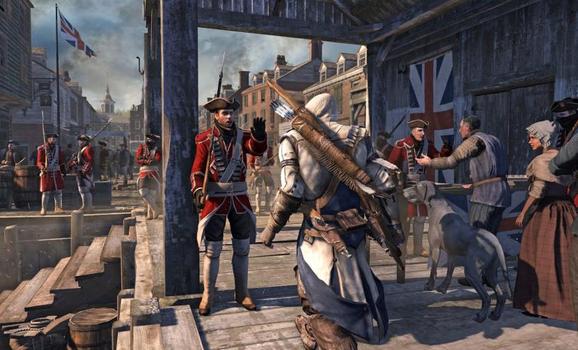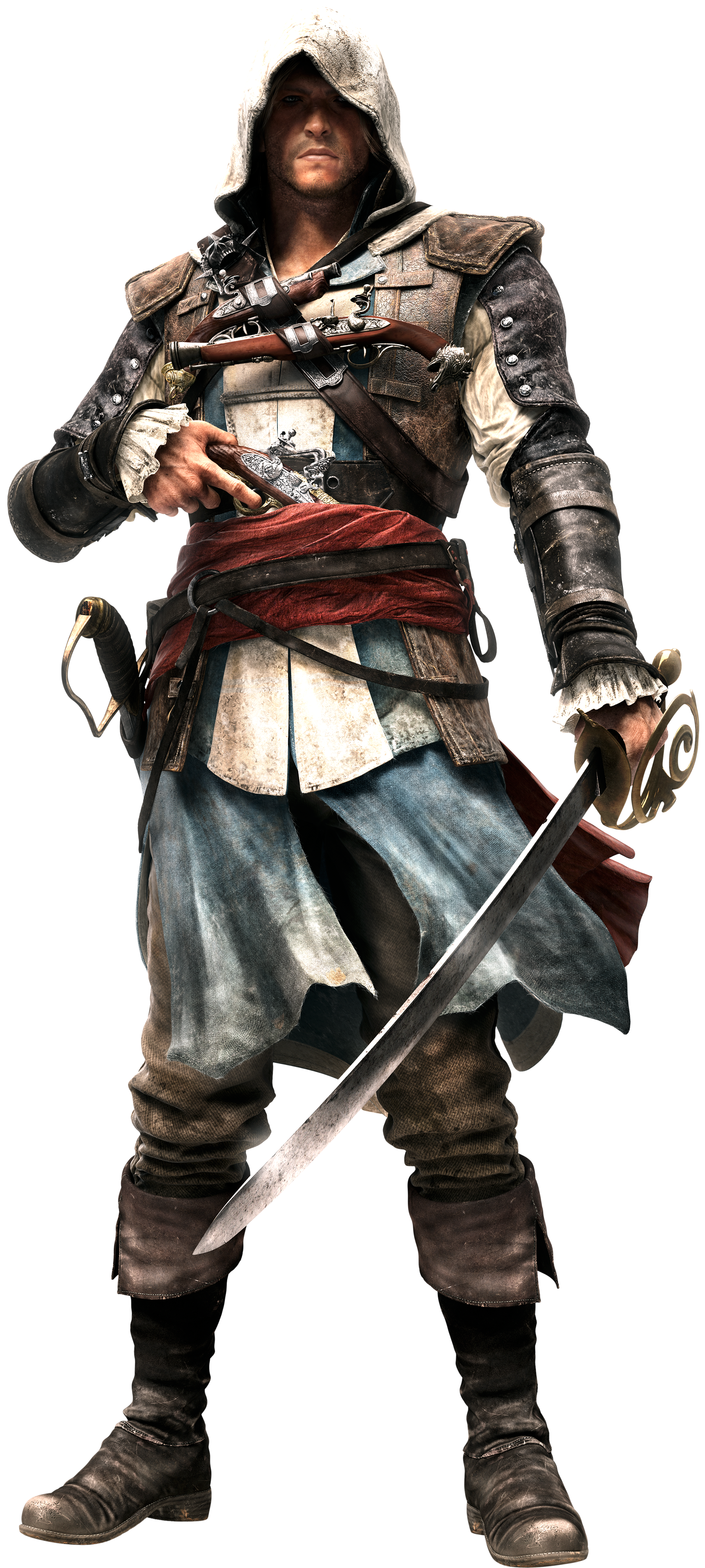
In our “What Star Wars Can Learn From” series, we’ve been examining lessons the Star Wars franchise can take from other successful series. Cooper kicked off the series with a look at Avatar (the Airbender franchise, not the blue people and special effects franchise). Now I’d like to take a look at the Assassin’s Creed franchise. It is, like most things these days, a multimedia franchise, but I’ll be focusing on the triple-A video games, which are the heart of the series and the only part with which the vast majority of people are familiar.
For the benefit of those not familiar with Assassin’s Creed, it is a series of video games published by Ubisoft in which users play the role of a modern-day man (Desmond Miles in all the games up to now) experiencing the adventures of his various ancestors through advanced technology. The core of the games is in the stories of these ancestors, members of an order of Assassins who fight against Templars who wish to create a “better” and more orderly world without respect to the freedom and rights of ordinary people. These ancestors appear across a range of historical settings, interacting with real historical figures, while living out a sort of “secret history” that plays with the idea, essentially, “What if every conspiracy theory was actually true and all rolled into this one struggle?” There have been five releases up to now, following three Assassin ancestors, and a sixth coming out on current-gen consoles this very day with a new Assassin, plus the PlayStation Vita release Assassin’s Creed III: Liberation, which followed an additional Assassin and will receive a full console port next year.
Lesson #1: The core concept matters more than recycling the same characters and setting
One thing you might have noticed from my description of the series is that there are a great many protagonists in the Assassin’s Creed universe. Desmond Miles, the player stand-in nominally unifying the games up to now, is in fact the least significant of the protagonists in screentime, story focus, and fan regard. No one is really here for Desmond; his ancestors are the stars of each game. His minimal involvement is just a frame story.
Yet Desmond is there, the modern-day Assassin. Then there’s Altaïr, the Assassin from the Crusades; Ezio, the Assassin from Renaissance Italy; Connor, the American Revolution Assassin; and now Edward, the pirate Assassin in the early-eighteenth-century Caribbean. That’s not even getting into the spinoff material, which has largely foregone the established characters in favor of people like the colonial Louisianan Aveline and, in the comics, American Daniel Cross and his Russian Revolution ancestors, the Orelovs.

From that list, you should be able to notice that there is no unity of character or setting in this franchise; its constant is change. Each numbered release has switched its protagonist and made a major timeline jump; even the one character who got multiple games, Ezio, moved from Italy to Constantinople for his final game.
What unites the series is the core concept: Assassins fighting Templars in a historical setting rich in interesting events or personalities. People enjoy each of the characters, but they’re not going to only come back to the series for Ezio or Altaïr. Fans don’t need endless adventures in the Holy Land or Renaissance Italy to be satisfied. Even the spinoffs don’t need to focus on giving fans more of the characters they love; they are free to give fans more of the universe by presenting wholly fresh aspects of it.
Ubisoft has avoided the misapprehension that the trappings of the first, or even the most successful, entry in the series must be repeated ad nauseam to keep fans buying. What hooks them is the core of what the franchise is, not seeing the same face in every story or getting the same thing every time.
This is a lesson that Star Wars could stand to take to heart. Star Wars projects as diverse as the prequels, Knights of the Old Republic, Legacy, the Jedi Knight series, X-wing, and the Republic comics have proven that fans don’t need to see the same old faces and the same old places to make Star Wars products successes. They are capable of falling in love with new characters, of being wowed by new worlds, of appreciating new types of stories, just as long as they still get that sense that they’re experiencing an amazing new Star Wars story. It doesn’t have to be a Luke story. Just a Star Wars story.
Yet too much of the Expanded Universe has spent its time insisting that the only thing people could possibly want is more Big Three stories. They keep hanging around, dominating stories in their sixties and seventies, as if people who have grown up with Jaina Solo for twenty years or read twenty-plus books featuring Ben Skywalker couldn’t conceivably be interested in those characters on their own merits.
Assassin’s Creed was successful enough to get a sequel. Altaïr was a fairly successful character, acquiring minor meme status briefly for his badass Assassin skills; it would have been easy to stick with him. Instead, the franchise moved on, introducing a new lead character, Ezio, who proved even more popular than Altaïr. So they gave him two sequels, then said, “That’s that,” as soon as his story was done and moved on, looking back at him even less than they did at Altaïr. A little bit of that confidence in the draw of the franchise, rather than the particulars of its first story, would go a long way in an EU that would rather play it safe with seventy-something Han saving the day in every book, or Tatooine in every third story, or the Battle of Hoth in every video game, than take the risk of giving fans something new to fall in love with.
Lesson #1.1: Make new characters new
Since the first lesson I offered was pretty broad, I think it’s worth discussing a few specific sub-lessons deriving from that principle that Assassin’s Creed illustrates particularly well. They can help illustrate ways the general idea can be put into practice.

One obvious lesson is to make new characters, and make them new. The first Assassin’s Creed‘s protagonist, Altaïr, was a stoic badass who killed on orders, a duty-driven silent-killer type. When Assassin’s Creed II came out, Ubisoft didn’t simply try to recreate its previous hit with another grim badass. Instead, it gave the world Ezio Auditore da Firenze, a carefree playboy youth. Completely unlike Altaïr in background and temperament, he came to the Assassins through a quest for revenge after Templars murdered his family, and while that tragedy tempered him with an underlying anger, he never lost his fundamentally jovial disposition. He was a fun, witty hero who drove his own story rather than acting on orders; he was about as unlike Altaïr as he could possibly be. Then came Ratonhnhaké:ton, AKA Connor, of mixed Mohawk and colonist ancestry, trying to find his place in the world. After the smash success of the outgoing, larger-than-life Ezio as a character, it would have been easy to lean on that formula. Instead, Connor was quiet, awkward, and driven not by duty or revenge, but by a deep sense of justice and determination to do the right thing and help others. Perhaps appropriately for an American Revolution game, he was an all-American Clark Kent or Steve Rogers type — again, about as far from his predecessor as possible.
Ubisoft’s writers didn’t try to retreat to formula in order to repeat prior successes. Instead, they innovated, making sure their new products offered new characters and new experiences. Star Wars likewise should seek not to make its new Jedi stand-ins for Luke or Obi-Wan, or to set out simplistically to recapture the magic of Han Solo in its scoundrel types. Its villains don’t need to be riffs on Darth Vader. Instead, it should have the courage to offer something new when it creates new characters (and for that matter, new settings and stories — I could just as easily recite the ways the Assassin’s Creed games have striven to make their locales radically different and their storylines varied, but this article is long enough already) and the conviction that freshness will, in the long run, carry the day and keep the franchise vibrant and vital much better than a universe that serves as an infinite Xerox machine, endlessly copying itself to poorer and poorer results.
Lesson #1.2: Tell your story and move on
Ubisoft made a game about Altaïr. He struggled with arrogance, but learned humility and to appreciate the philosophy of the Assassin Order. Then, rather than try to wring him dry, Ubisoft moved on. They didn’t try to tell The Endless Adventures of Altaïr. Instead, they told the story of Ezio. He spent three games learning and growing as a person, achieving his goals, maturing his outlook. Then he got old and died, and the next game was about Connor. He fought in the American Revolution and it ended, and now the franchise is moving on to Edward Kenway and his story.

In each case, each Assassin could potentially offer more stories. Not only in the sense that an Assassin must have a lifetime of missions and activity, thought that certainly is relevant, but Altaïr and Connor especially are left at the end of their games with arcs that have foreseeable continuations; Altaïr’s philosophical maturation and Connor’s shattered self-image leave evident possibilities for further growth, the kind of extended arc Ezio received in his sequels. And while Assassin’s Creed: Revelations did attempt to show a few highlights from Altaïr’s later life, and both Altaïr and Ezio received minor handheld and mobile games showcasing further-adventures spinoffs, the series as a whole has been extremely restrained about bringing its characters out for more. It has preferred to err on the side of leaving the audience wanting more rather than saturating the market with neverending attempts to keep Altaïr, Ezio, and Connor going.
Now, there’s certainly a place in Star Wars for more-of-the-same adventures to fill our demand to see our favorites in action again. But in terms of the overall timeline, the Expanded Universe would be well advised to keep the core lesson in mind: tell your story, put your characters through their arcs, and then move on. Ezio gets old and dies, and it’s better to see Connor’s life than to keep hanging big event after big event on Ezio. The Big Three saved the galaxy from the Empire, then worked with their kids and students to save the galaxy from the Yuuzhan Vong. That’s your arc right there, and there’s nothing wrong with moving on to the next people’s stories, to the arcs of that next generation, going back for a few smaller interstitial stories every now and then. Inventing further arcs, or dragging characters who have long since stopped developing and no longer have real arcs through big stories for their own sake is wasteful and ultimately unsatisfying. Star Wars deserves better than that.
And that leads in well to lesson number two . . .
Check in tomorrow for the conclusion of this post, addressing the second and third lessons from Assassin’s Creed.

More Pirates and Italian City State like political intrigues would definitely benefit SW 😉